| Srl | Item |
| 1 |
ID:
090220
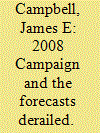

|
|
|
|
|
| Publication |
2009.
|
| Summary/Abstract |
On September 8, 2008, the Trial-heat Forecasting Model predicted that in-party candidate Senator John McCain would receive 52.7% of the national two-party popular presidential vote. The forecast of a victory of modest proportions for Senator McCain reflected his having a five-percentage-point lead over Senator Barack Obama in Gallup's early September, post-convention poll (49% to 44%) and the Bureau of Economic Analysis' August report of a 3.3% GDP growth rate in the second quarter of the year, about average for a second quarter election year economy.
|
|
|
|
|
|
|
|
|
|
|
|
|
|
|
|
| 2 |
ID:
134789
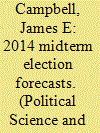

|
|
|
|
|
| Summary/Abstract |
In about two months, more than 90 million Americans (roughly 40% of those eligible to vote) will elect 435 members of the US House of Representatives and 36 members of the US Senate. The results of this midterm election will go a long way in determining the direction and extent of political change during the next two years. At present, like the nation itself, Congress is divided. Democrats hold a majority in the Senate, Republicans a majority in the House. To take control of the House, Democrats must gain 17 seats beyond the 201 they won in 2012 or 19 more than their current 199 seats (with three vacancies). Republicans must pick up six seats to regain their Senate majority. The Senate’s current party division is 53 Democrats and 45 Republicans. The two independents who caucus with the Democrats and the vice presidential tie-breaker put the Republicans’ magic number at six.
|
|
|
|
|
|
|
|
|
|
|
|
|
|
|
|
| 3 |
ID:
116453
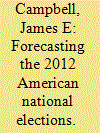

|
|
|
|
|
| Publication |
2012.
|
| Summary/Abstract |
This symposium presents 13 articles forecasting the 2012 US national elections. Included in this collection are the eight national and one state presidential vote forecasting models published in PS: Political Science & Politics during the 2008 elections along with three additional forecasts and one article offering a composite of the forecasts. Although the focus remains on the presidential contest, as in past years, several articles extend their scope to cover the congressional elections as well.
|
|
|
|
|
|
|
|
|
|
|
|
|
|
|
|
| 4 |
ID:
116458
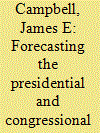

|
|
|
|
|
| Publication |
2012.
|
| Summary/Abstract |
This article presents forecasts of the 2012 presidential and US House of Representatives elections. The presidential forecasts are of the national two-party presidential vote percentage for the in-party candidate and are based on the trial-heat and economy forecasting equation and its companion convention-bump equation. The House election forecast is of the net seat change for the Democratic Party from 2010 to 2012. This forecast is produced from two versions of a seats-in-trouble forecasting equation.
|
|
|
|
|
|
|
|
|
|
|
|
|
|
|
|
| 5 |
ID:
131651
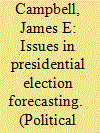

|
|
|
| 6 |
ID:
153789


|
|
|
| 7 |
ID:
100775


|
|
|
|
|
| Publication |
2010.
|
| Summary/Abstract |
All indications are that 2010 will be a very good year for Republicans. After two election setbacks, they are poised for a comeback. Partisanship, ideology, the midterm decline from the prior presidential surge, the partisanship of districts being defended, and even President Obama's approval ratings have set the stage for significant seat gains by Republicans in the House.
|
|
|
|
|
|
|
|
|
|
|
|
|
|
|
|
| 8 |
ID:
134792
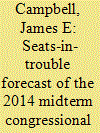

|
|
|
|
|
| Summary/Abstract |
One of the most commonly referenced generalizations about congressional elections is attributed to Speaker of the House Thomas P. “Tip” O’Neill. According to the venerable Speaker, “All politics is local.” Of course, in the broad sense, this is far from the case. A vast body of research and evidence indicates that national political conditions greatly shape congressional vote decisions and election outcomes. 1 But in a strict sense, it and its companion generalization— all politics is short-term— are difficult to argue with. At least formally, elections are decided by the actions of individual voters expressed at the ballot box on Election Day (or thereabouts). To be of consequence, national and long-term considerations must influence the political decisions made in the here and now—local and current.
|
|
|
|
|
|
|
|
|
|
|
|
|
|
|
|
| 9 |
ID:
168724
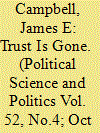

|
|
|